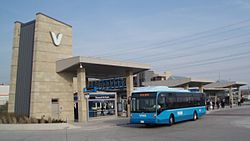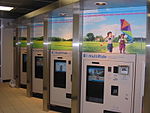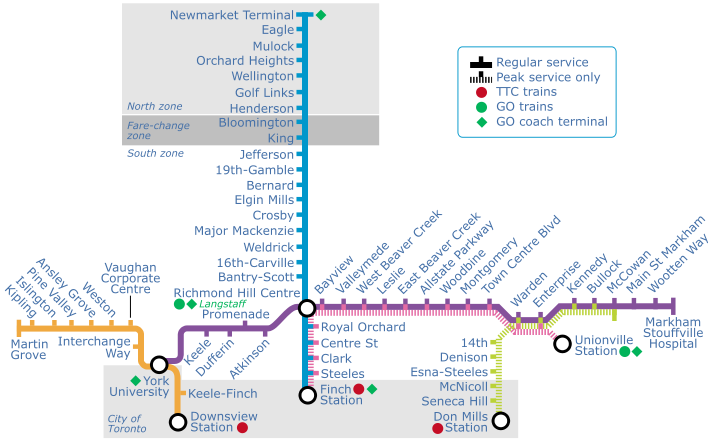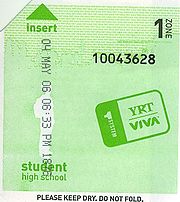- Viva (bus rapid transit)
-


A Viva bus at the Richmond Hill Centre TerminalSlogan From A to being...Alive Parent York Region Transit Founded 2005 Headquarters 50 High Tech Road,
Richmond Hill, ON L4B 4N7Locale York Region, ON Service area York Region along the Highway 7 and Yonge Street corridors Service type Quality express bus Routes 5 Stations 59 Fleet 60 40' units
56 60' unitsOperator 4286847 Canada, L.P.
(Veolia Transportation)Web site Official Website Viva is a bus rapid transit[1] service operating in York Region, Ontario, Canada. Viva service is integrated with York Region Transit's local bus service to operate as one regional transit system providing seamless transit service across York Region and connections to northern Toronto.
Viva was designed and built using a Public-Private Partnership (P3) model. York Region partnered with York Consortium, which comprises seven private sector firms with extensive international experience in transit design, architecture, construction and operations. Under the terms of the partnership agreement, public sector responsibilities include establishing fare policies and service levels, ownership of all assets, and control of revenues and funding. Private sector responsibilities include providing professional staffing and procurement support, assuming risk on all approved budgets and schedules, and assisting York Region in its funding and financing requirements.
Viva officially opened in stages commencing September 6, 2005. The second stage opened on October 16, 2005, the third on November 20, 2005, and the fourth on January 2, 2006.
Five routes are currently in operation: Viva Blue, Viva Purple, Viva Orange, Viva Pink, and Viva Green.
Contents
Overview
Viva is the first phase of York Region's rapid transit plan to reduce congestion on local roads. The next phase is called vivaNext.
The service uses high-end Belgian-built Van Hool and Canadian-built NovaBus buses referred to as "rapid transit vehicles" (RTVs), which make use of existing or specially lengthened right-turn lanes to move through intersections ahead of traffic, as well as bus-only lanes and roads to bypass traffic altogether. They are given priority at traffic signals. Viva RTVs run 18 hours a day, 7 days a week, from 5:30 a.m. to midnight on weekdays, 6:30 a.m. to midnight on Saturdays and 8:00 a.m. to midnight on Sundays. During peak hours (6:30 a.m. - 9:00 a.m. and 4:00 p.m. - 6:30 p.m.), buses arrive every three to ten minutes depending on the route. Outside of peak hours, RTVs arrive less than 15 minutes apart.
Stops along the routes are referred to as "vivastations", and incorporate a ticket vending machine, a ticket validator, and a Presto card reader (fares are on a proof-of-payment basis to speed up boarding times), as well as a real-time "smart" displays that notify passengers when the next vehicle is expected to depart. Most vivastations are blue, but several on Yonge Street have a unique bronze design referred to as "vivavintage" in order to better suit the historic areas of Thornhill, Richmond Hill, and Aurora. Where space is limited, vivastations are served by miniature "vivamicro" stations. Vivastations on York University's campus are red in keeping with the University's signage policy.
Viva routes connect to Toronto Transit Commission's Yonge, Spadina, and Sheppard subway lines, GO Transit trains and buses, and to a number of Toronto bus routes. Viva is integrated with YRT's existing bus network, and passengers are able to pay one fare to use both Viva and the regular bus system. Fares are valid for unlimited use for two hours from the time of purchase. Drivers do not sell tickets or handle fares, to speed up boarding times. A "proof of payment" system is used where passengers must show that they have a valid ticket, when asked to provide one.
On March 31, 2005, at a Regional Municipality of York Council meeting, the contract for the operations and maintenance of the entire Viva fleet for its first five years of service was approved to be awarded to Veolia Canada. The approved contract was valued at $112,496,870, inclusive of Goods and Services Tax.
Routes
Line Opening Date Terminus Stations # Running time (mins)* Status Connecting Services Viva Blue September 4, 2005 (Finch to Bernard)
November 20, 2005 (Bernard to Newmarket)Finch Newmarket 24 52 Full Service, Fare Zone Change Required YRT, TTC (Subway and Buses), GO, Viva Purple, Viva Pink Viva Purple September 4, 2005
(York University to Town Centre)
October 16, 2005 (Enterprise to McCowan)
January 27, 2008 (McCowan to Markham-Stouffville Hospital)York University Markham Stouffville Hospital 23 61 Full Service - New Nova Bus LFXes do not run on Viva Purple Routes due to the large size of the vehicles and Purple's Lower Ridership
YRT, TTC (Buses), GO, Viva Orange, Viva Blue, Viva Pink, Viva Green Viva Orange October 16, 2005 Martin Grove Downsview 12 30 Full Service; Passengers south of Steeles are allowed to embark and disembark YRT, TTC (Buses, Subway), Viva Purple Viva Pink January 2, 2006 Finch Unionville 18 43 Peak Service (06:30 - 09:30 ; 15:30 - 19:00) YRT, TTC (Buses, Subway), GO, Viva Blue, Viva Purple, Viva Green Viva Green October 16, 2005
(Don Mills to 14th Avenue)
November 20, 2005
(Warden to McCowan)Don Mills McCowan 11 39 Peak Service (06:30 - 09:30 ; 15:30 - 19:00) ; During Southbound services, passengers are not allowed to embark south of Steeles Avenue, during Northbound services, passengers are not allowed to disembark south of Steeles Avenue YRT, TTC (Buses, Subway), Viva Purple, Viva Pink * Running time based on normal traffic and weather conditions, retrieved from the YRT website.
As Viva’s mandate does not include local service in the city of Toronto, Viva vehicles travelling south of Steeles Avenue (the regional boundary) do not pick up passengers when travelling southbound, and do not allow passengers to disembark when travelling north. However, TTC customers intending to go to York University can use their TTC transfers and passes as proof-of-payment aboard Viva vehicles and do not have to pay another fare. TTC Customers heading southbound from York University without a TTC Metropass or TTC transfer, however, will need to buy an additional YRT\Viva ticket to board Viva Orange. This arrangement was adopted to reduce overcrowding on the TTC's 196 York University Rocket, while generating an additional revenue stream from the Viva Orange service, which has capacity for additional customers. The TTC pays YRT 49 cents for each TTC customer it picks up. It currently costs the TTC 97 cents per passenger boarding on route 196 York University Rocket.[3]
In 2009, YRT/Viva bus schedules became available on Google Transit; trip planning, detours, and fare information are available to riders over the Internet.[2]
Major locations and terminals
Main article: List of York Region Transit/VIVA stationsViva operates at several major locations and terminals, with vivastations (the names of the stations in brackets) at:
- Finch Station - north of Finch TTC station. An elevator and Viva fare machines are available.
- Newmarket Terminal - across from Upper Canada Mall on Davis Drive, at Eagle Street West (Newmarket Bus Terminal).
- Richmond Hill Centre - Yonge Street at Highway 7/Highway 407 next to Silvercity Richmond Hill theatres. Langstaff GO Station is accessible through a pedestrian overpass.
- Promenade Terminal - in Vaughan on the north side of Promenade Mall (T&T Supermarket), on Centre Street west of Bathurst Street.
- Bernard - on east side of the mall on Yonge Street at Bernard, just north of Elgin Mills Road.
- York University, at York Commons on Ian Macdonald Blvd, right outside of the Archives of Ontario building.
- Don Mills Station - located outside the TTC's Fare Paid Zone, near Fairview Mall (Don Mills Station) on Don Mills Road opposite Leith Hill Road, just north of Sheppard Avenue, as well as inside the fare-paid zone.
- Downsview Station - located outside the TTC Fare Paid Zone, on Sheppard Avenue West at Allen Road, as well as inside the fare-paid zone.
- Unionville Station - located adjacent to the Highway 407 and Kennedy Road interchange (exit 88) in Unionville, in the city of Markham.
Future terminals
Cornell Terminal was originally planned to open in July 2007, but has been postponed. The terminal is to be built near Markham Stouffville Hospital, near the intersection of Markham By-Pass and Highway 7.
Vaughan Corporate Centre, already existing as a stop, is to be relocated to a spot on Highway 7 directly above the Vaughan Corporate Centre (TTC) subway station currently under construction, thus turning it into a terminal. It will become the largest VIVA station on the network due to extra space required for escalators and elevators.
Wootten Way and Main St. Markham vivastations currently serve the Viva Purple line, but will serve the Viva Green line in the future, in conjunction with the extension of Viva service to Cornell.
Fares
 A Presto card reader at the Promenade Terminal.
A Presto card reader at the Promenade Terminal.
Both Viva and YRT are part of YRT's 1system fare policy. This means that a Viva fare and a YRT fare are treated the same, and that riders can transfer from either service to the other without having to pay an additional fare. Riders can also transfer from TTC buses operating in York Region, assuming that they have paid the YRT fare when boarding the TTC bus (when in York Region) or exiting the TTC bus (when travelling to York Region from Toronto).
YRT/Viva operates on a three zone fare system. Much of southern York Region is in one zone(comprising the city of Vaughan, the Town of Richmond Hill, the Town of Markham and southern areas of the Township of King and the Town of Whitchurch-Stouffville). Central York Region is in another zone (comprising the Town of East Gwillibury, the Town of Newmarket, the Township of King, the Town of Aurora, and the Town of Whitchurch-Stoufville). The third fare zone is in the Town of Georgina. The Oak Ridges Moraine divides the zones. Georgina, which constitutes another zone at least for Mobility Plus riders, does not have local bus connections to any other zone at present. Fares within Georgina are basically the same as for one-zone in the southern municipalities. Transfers are accepted if a rider uses the GO Bus in between YRT routes, and YRT fares are accepted on the GO bus, with payment of a zone supplement.
Riders can purchase single ride fares from "oneRide" ticket machines, available at all vivastations. In addition, riders may purchase multiple ride fares from authorized vendors or at "multiRide" ticket machines, available at select terminals where Viva operates. Single ticket fares are good for a 2-hour time window (expiry time printed on ticket) on any Viva or YRT route.
To reduce time spent loading passengers, Viva routes employ a proof-of-payment fare system. Fare Inspectors travel vehicle to vehicle to ensure that passengers have paid their fares. Those caught without valid proof of payment are subject to a fine. Students must produce an authentic student ID card to use student fares (TTC Student ID cards are considered a valid student ID).
Beginning July 1, 2006, monthly passes for YRT/Viva became eligible for a 15.5% tax credit from the Government of Canada, which can be claimed when filing tax returns at the end of the year, with proof of purchase. This was reduced to 15% for 2007 and subsequent years.
In July 2011, the Presto card was launched in York Region, providing another payment method.
Tickets are available for one or two zone fares. Effective January 1, 2009, the following fares are in force:
Effective January 1, 2009: Fare Category Cash Fare 10 Tickets Monthly Pass one-zone two-zone one-zone two-zone one-zone two-zone Adult $3.25 $4.25 $26.00 $36.00 $105.00 $150.00 Student (High School) $3.25 $4.25 $19.00 $29.00 $75.00 $120.00 Senior/Child $3.25 $4.25 $15.00 $25.00 $46.00 $78.00 Express $3.50 -- $32.50 -- $120.00 -- Ticket machines
 Viva ticketing machines at the Finch Bus Terminal.
Viva ticketing machines at the Finch Bus Terminal.
Currently, the ticketing machines operate on Microsoft Windows 2000 and a customized Viva client. Because of the large number of people using the ticketing machines in terminals, they are inspected often and usually in good working order. All ticket machines not in terminals have a validation machine attached to their sides. For many ticketing machines inside the terminal, the validation machine is separated from the ticket machines because many of the ticket machines are side by side.
At ticket machines labelled "oneRide", one can purchase single ride Student (student ID required when riding), Adult, or Child/Senior tickets (seniors are required to show their ID). As they have been pre-validated, they must be used immediately upon purchase. "oneRide" machines accept coins (but are not able to return change) and credit cards (MasterCard and Visa), and are available at all vivastations.
At ticket machines labelled "multiRide", one can purchase multiple tickets in packs of 10 for Student, Adult, or Child/Senior fares. Zone upgrades can also be purchased from these machines. "multiRide" machines are available at select terminals and accept coins, bills of up to $20 (and are able to return change) and debit cards (Interac), and are available at select terminals. "multiRide" ticket machines are also under the ATM networks Cirrus and Plus.
As of 2007, vivastations (as well the vehicles themselves) began having dome security cameras installed to prevent abuse to the machines.
Vehicles and fleet rosters
 Viva's vehicles are intended to be much more luxurious than is usual for public transport in North America.
Viva's vehicles are intended to be much more luxurious than is usual for public transport in North America.
 Viva bus interiors are intended to be more comfortable in design than normal transit buses, and are equipped with "Next Station" prompts and information screens.
Viva bus interiors are intended to be more comfortable in design than normal transit buses, and are equipped with "Next Station" prompts and information screens.
Viva's initial stock includes 85 buses of two models, referred to as Rapid Transit Vehicles (RTVs) all delivered by the beginning of 2006. In addition, 15 Novabus LFXs joined the fleet in 2011:
Make/Model Description Fleet # Notes Van Hool  Belgium
BelgiumArticulated newAG300 5201-5225, 7201-7205, 8201-8211 
Length: 18 meters (60 ft)
Cost per vehicle: $742,000
Engine/Transmission: Cummins ISM/Voith D864.3E
(Cummins ISL/Voith D864.5 for 8201-8211)Van Hool  Belgium
BelgiumnewA330 5101-5160 
Length: 12 meters (40 ft)
Cost per vehicle: $494,000
Engine/Transmission: Cummins ISL/Voith D864.3ENovabus  Canada
CanadaArticulated
LFX1080–1094 (36 units more by 2015) - Run only on Viva Blue/Blue "A" Routes

Length: 18 meters (62 ft)
Cost per vehicle: $902,234
Engine/Transmission: Cummins ISL9/Voith D864.5Ford Motor Company Ford Focus  USA
USAN/A compact station wagons - support vehicles Similar buses are being used in Longueuil (Montreal's South Shore) by Réseau de transport de Longueuil, and in Oakland, California by AC Transit.
 All Viva vehicles are wheelchair-accessible.
All Viva vehicles are wheelchair-accessible.Future extensions
The next phase of the Viva Rapid Transit System is called vivaNext. The vivaNext plan includes the extension of the Spadina subway line north from Toronto to Vaughan Metropolitan Centre and the extension of the Yonge subway line north from Toronto to Richmond Hill Centre. This will be the first time in history that York Region will be serviced by subways. Funding for the 8.7 kilometre Spadina subway extension from Sheppard Avenue to Highway 7 has received a funding commitment from all three levels of government and is expected to be fully operational by 2015.(http://www.vivanext.com/spadina_extension)
The Environmental Project Report for the Yonge subway extension was unconditionally approved by the Ministry of the Environment in 2009. The 6.7 kilometre extension from Finch Avenue to Highway 7, is one of the top 15 priority projects of Metrolinx, the provincial transportation agency. (http://www.metrolinx.com/Docs/big_move/Backgrounder_Top_15_Priorities_Final_11_28_08.pdf) A conceptual design contract was initiated in 2010 to maintain momentum on the project and provide a stronger foundation for moving it forward.
The VivaNext plan also includes the construction of dedicated bus lanes called rapidways. They will take Viva RTVs out of mixed traffic along segments of some of the region’s busiest corridors – Highway 7, Yonge Street and Davis Drive, reducing ride times by up to 40%. VivaNext rapidways will improve connections between regional growth centres and provide links to other key transit services such as GO Transit and the TTC subway system. Eventually, vivaNext may replace buses on the dedicated rapidways with a light rail transit system. (http://www.vivayork.com/)
In November 2008, the provincial transportation agency Metrolinx selected two infrastructure projects for construction beginning in 2009, including major components of the vivaNext plan. Metrolinx gave its final approval to a $7 billion, five-year capital plan that includes over $1 billion for construction of several vivaNext rapidways. (http://www.metrolinx.com/Docs/big_move/Backgrounder_Capital_Plan_Final_11_28_08.pdf)
In the spring of 2009, the Province of Ontario committed $1.4 billion for vivaNext rapidways. The Cornell Terminal in Markham has received $5.6 million in funding through the provincial government's "Quick Wins" program..
Previous expansions to the Viva Rapid Transit System include Viva Purple. The Purple line was extended to Markham Stouffville Hospital on January 27, 2008, providing service to three new vivastations: Main Street Markham, Wootten Way, and Markham Stouffville Hospital.
YRT/Viva have also identified a partnership with Brampton Transit's Züm, a service similar to Viva operating in the Region of Peel, as a priority. Connections along Highway 7 are expected to start upon Züm's launch. Integration with Brampton Transit, Page 7
Customer relationship
Customer appreciation days
Two times each year, Viva/YRT give away free drinks and snacks to thank their riders for support.
Free rides on New Year's Eve
Viva/YRT offer free transportation on New Year's Eve (after 7 p.m. on December 31).[3]
Free travel for veterans on Warrior's Day
Veterans and a companion, or immediate family of a deceased veteran are offered free travel on Warrior's Day.[4]
Veterans free rides on Remembrance Day
Viva/YRT offer free transportation for veterans or immediate family of a deceased veteran on Remembrance Day.[5]
Notes
- ^ Viva vehicles are so un-bus like, we call them rapid transit
- ^ "YRT/Viva and Google have teamed up to give riders another trip planning option". http://www.yrt.ca/googletransit/index.asp. Retrieved January 16, 2009.
- ^ "MyTransit Newsletter Winter 08/09". http://www.yrt.ca/news/MyTransit_Winter0809_final.pdf. Retrieved December 11, 2008.
- ^ "MyTransit Summer 09". http://www.yrt.ca/news/mytransit/MyTransit_Summer09.pdf. Retrieved August 9, 2009.
- ^ "MyTransit Newsletter Winter 08/09". http://www.yrt.ca/news/MyTransit_Nov2008_final.pdf. Retrieved December 11, 2008.
See also
General
- List of rapid transit systems
- Veolia Transportation - operator of Viva
York Region Transit predecessors
Greater Toronto Area transit
- GO Transit
- MoveOntario 2020
- Züm - Brampton Transit's BRT
References
Viva publications
- Viva - A Rider's Manual, York Region September 2005
- Viva - York Region Rapid Transit Route Map 2005
- the viva rapid transit vehicle/rtv:ag300 2005
- "Viva RT - New Transit System Coming Soon", About Markham, p. 2. June 2005
- MyTransit, York Region Transit, September 2005. (PDF)
Government publications
- Viva Rapid Transit Phase One Operations and Maintenance Services Contract. Minutes of Council – March 31, 2005, Regional Municipality of York, March 31, 2005.
- Viva Fare Collection Equipment, Maintenance Services Sourcing, Minutes of Council – June 23, 2005, Regional Municipality of York, June 23, 2005.
- Viva rapid transit Fact Sheet, Regional Municipality of York, September 6, 2005.
- Yonge Street Environmental Assessment, Regional Municipality of York, November 10, 2005.
Newspapers
- "vivatalk - York Region's Rapid Transit Update", Economist & Sun/Sun-Tribune: Community, p. 7. June 11, 2005
- "Bus Riders find bearings", Toronto Star, p.B3, September 7, 2005.
Other sources
- "Ontario and Beyond - York Region Rapid Transit Plan", Transfer Points June–July 2004, p. 5-6.
External links
- YRT Information Site
- YRT/VIVA Fare Rates
- vivaNext (requires Shockwave Flash)
- The Toronto LRT Information Page (possible VIVA LRV rendering is shown)
Public transport in the Greater Toronto Area Agencies Rail Amtrak • GO Transit • Hurontario-Main Street LRT • LINK Train • Ontario Northland • Toronto streetcar system • Toronto subway and RT • Via RailBus and coach GO Transit • Mississauga Transitway • Toronto Transit Commission buses • Viva • ZümMajor stations Ajax Plaza Bus Terminal • Bramalea Terminal • Finch Bus Terminal • Mississauga City Centre Transit Terminal • Newmarket Bus Terminal • Oshawa Bus Terminal • Richmond Hill Centre Terminal • Scarborough Centre Bus Terminal • Square One Bus Terminal • Toronto Coach Terminal • Union Train Station and Bus TerminalAccessible transit Related articles Presto card • The Big Move • Transit CityCategories:- VivaYork
- 2005 introductions
- Bus rapid transit in Canada
Wikimedia Foundation. 2010.








